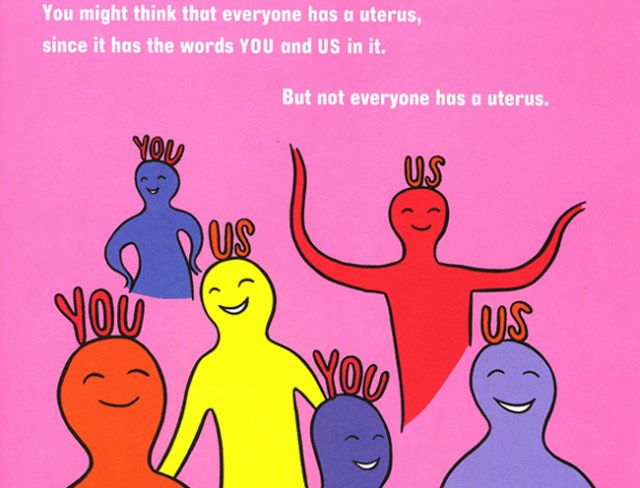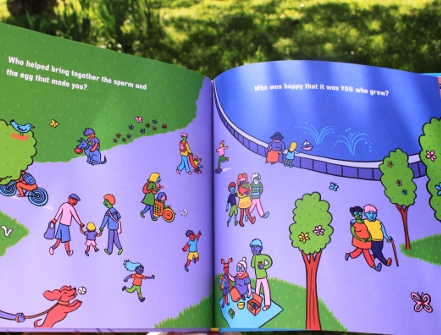When I first received What Makes a Baby by Cory Silverberg, and illustrated by Fiona Smyth, I was thinking I’d try to find a child to help me review it. After all, it is a children’s book. And there’s certainly no shortage of children in my family – I’m one of four and have six nieces and nephews – but my siblings and their lovely offspring live v. far away. I then contemplated sending it to them, or to some of my friends with children. The editors asked me, “well, what age group is it made for? We’ll see if we can find somebody.” So I sat down with the book and opened it, thinking I would just find out exactly who this was made for and then connect with that small person.
What I actually did was cry. All over the book. All the crying.
I thought I was prepared for this book – our very own Prairie Homo Malaika covered the book trailer because the authors are Canadian, further proof that Canada knows what’s up. I’d read an article about it even before that: this book explains how babies are made in a gender neutral way, AKA directly opposite to the way I grew up learning how babies were made. Simple, right?

via The Atlantic
Until you get it in your hands and you smell that smell that only children’s books have and you’re transported back to your childhood when your whole bookshelf smelled like that. And then you crack it open and GASP not everything is pink and blue. And as you’re reading it, you realize that if you ever make a baby, or if you have, your experience is going to look a lot like the experience laid out in this book. Like, dammit if your egg isn’t gonna be blue and have illustrations of books and puppet plays inside. Like THAT’S EXACTLY HOW YOU PICTURE YOUR EGG. And you just sigh with relief because you realize that when you do make a baby, you don’t look like any of the mothers in any children’s book you had growing up. And now you do. And then you cry, because someone gets it.
I’m totally not substituting “you” for “I.” Naww.
So instead of trying to get a child’s perspective on this book and mailing it to someone, I instead clutched the book to my chest and will never let it go and will keep it for my hypothetical/imaginary/future/badass queerspawn.
I’ll try to step away from my feelings long enough to deliver a coherent review of this book, which I’m pretty sure I’m only capable of doing in list form:
+ Fiona Smyth’s illustrations look exactly like the inside of my childhood brain. They’re colorful, whimsical, they echo the drawings of a child while still demonstrating the wicked skill of a well-trained artist. She’s used bold colors that don’t stick to the pink/blue binary of many baby books and baby discussions.
+ This book is conversational about science. This is valuable for all humans when they’re small – it makes them curious about science, which is important. Silverberg takes something science-y and presents it like you would present it talking to the small humans in your life. For example: “Every body that has a uterus always has it in the same place, just below the belly button, in the squishy middle part.” D’awww.
+ I am a huge fan on non-human-colored human illustrations, and this book has figures in just about every color. Blue, purple, pink, red, green. I feel like it makes the story more universal. And then there’s never a really stereotypical drawing or something to give a reader pause. Plus they’re adorable. Plus in an age where many of us grew up with Bart Simpson, I feel like we can all get behind this, nostalgia/positive-feelings-wise.
+ This is probably the most accurate representation of a park in the history of children’s books.

via XO Jane
And what I mean by that is there’s every configuration of group, there’s a variety of ability statuses, there’s so much gender presentation wonderfulness going on here: short hair, long hair, skirts, pants, tees, dresses – it’s really really exactly what every park I ever visit looks like.
+ There is a 60 page free downloadable reader guide for adults who need to have these conversations with children, which is excellent. It ranges from very basic to “Guiding Your Child To a Completely Intersectional Understanding of Sexuality and How It Relates to Gender, Race, Ability Status and Differences.” Silverberg provides some common questions children ask while reading the book and some example answers and includes an entire page-by-page breakdown of why things are written the way they are.
+ This book is all about creating a space to have a conversation. From the reader’s guide:
There isn’t one story of conception, gestation, and birth. Most books choose to focus on specific physiological and anatomical details of how babies are made. What Makes a Baby focuses on a different part of the story.
It focuses on the child’s experience and leaves many blank spaces to allow the adult reader to share stories, and to allow the children to ask questions. This book doesn’t pretend to give you all the answers. I know that can feel frustrating or worrying at first, but I think you might be amazed (and amused) by the results of reading this with your child.
There isn’t one way to educate or raise a child, and there certainly isn’t one way to talk about reproduction, bodies, and sexual health. What Makes a Baby is designed to give you, the adult reader, as much space as possible to educate and communicate in a way that fits for you, your child, your family, and your community.
All in all, this is a must have. A staple for every household with children, especially with the abysmal state of sex education in the U.S. Read this with the queerspawn and other badass offspring in your lives to ensure they’re learning accurate information and to create a space for you to share the other kinds of values you’ve got re: bodies, science and diversity. Because it’s not just sex education. It’s life education. Humans are all a little bit the same and a little bit different – isn’t it wonderful?
I can almost assure you all that I’m not alone in being very excited for Silverberg’s forthcoming books that delve a little bit deeper into topics like surrogacy and sperm donation. Bravo, Cory Silverberg, bravo.
You can order your copy of What Makes a Baby right here, right now. Download the Reader Guide while you’re waiting for it to arrive.



I’M BUYING THIS FOR MY NIECE. She needs to learn this shit early before society can mess up her tiny little brain too much.
New book to add to the summer reading list!
This makes me wish I had children right now, just so I had an excuse to buy this book and read it with them!
This is so exciting!!!! I’m so happy to know that it’s already out!
Just bought it to read to my daughter – thanks! We aren’t to those questions yet, but with a new baby cousin on the way, I’m sure they’re coming any day now.
I love everything about this book and this review, but:
“This is probably the most accurate representation of a park in the history of children’s books.”
This made me a little sad about the parks I go to and that I bring the small humans in my life to, because they are not very much like that. (Also you’d probably get fined if you tried to float a boat in a fountain.)